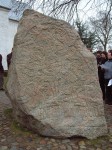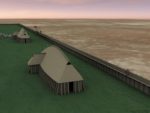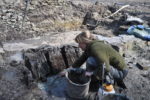 The town of Jelling in Jutland, Denmark, was the seat of the earliest kings of Denmark in the 10th century. Today the Jelling complex consists of two large burial mounds, two monumental runestones and a small church built on the site of three earlier wooden churches going back 1,000 years. The combination of tumuli, runestones and church capture the transition from the traditional Norse religion to Christianity. King Gorm the Old, the first king of Denmark, dedicated the smaller and older of the runestones. The inscription translates to: “King Gormr made this monument in memory of Thyrvé, his wife, Denmark’s adornment.” His son Harald Bluetooth had the second, much larger stone raised and its runic inscription reads: “King Harald bade this monument be made in memory of Gorm his father and Thyra his mother, that Harald who won for himself all Denmark and Norway and made the Danes Christians.”
The town of Jelling in Jutland, Denmark, was the seat of the earliest kings of Denmark in the 10th century. Today the Jelling complex consists of two large burial mounds, two monumental runestones and a small church built on the site of three earlier wooden churches going back 1,000 years. The combination of tumuli, runestones and church capture the transition from the traditional Norse religion to Christianity. King Gorm the Old, the first king of Denmark, dedicated the smaller and older of the runestones. The inscription translates to: “King Gormr made this monument in memory of Thyrvé, his wife, Denmark’s adornment.” His son Harald Bluetooth had the second, much larger stone raised and its runic inscription reads: “King Harald bade this monument be made in memory of Gorm his father and Thyra his mother, that Harald who won for himself all Denmark and Norway and made the Danes Christians.”
Within the perimeter of Jelling, the massive cultural shift from the reign of Gorm (936- ca. 958) to that of Harald (958– ca. 986) is documented in language, funerary and religious architecture. That’s why the Jelling mounds, runestones and church are on the UNESCO World Heritage List and why the site is one of the most important in Danish history.
 In 2006, archaeologists were able to explore a previously inaccessible area: the bed of a pond across from Gorm’s Mound. Before a planned renovation, the pond was pumped dry giving archaeologists the opportunity to excavate the mucky bottom looking for remains of the large wooden stockade that once encircled the royal estate at Jelling. Postholes from the stockade had been found before, but no physical remains. The stockade was known to have intersected part of what is now the pond, and therefore there was a chance the thick clay and mud on the bottom of the pond had preserved the organic remains of the stockade’s timbers. Viking-era reports suggested there had been a body of water in the area when the stockade was built, so conditions for preservation of wood may have existed on site since the 10th century.
In 2006, archaeologists were able to explore a previously inaccessible area: the bed of a pond across from Gorm’s Mound. Before a planned renovation, the pond was pumped dry giving archaeologists the opportunity to excavate the mucky bottom looking for remains of the large wooden stockade that once encircled the royal estate at Jelling. Postholes from the stockade had been found before, but no physical remains. The stockade was known to have intersected part of what is now the pond, and therefore there was a chance the thick clay and mud on the bottom of the pond had preserved the organic remains of the stockade’s timbers. Viking-era reports suggested there had been a body of water in the area when the stockade was built, so conditions for preservation of wood may have existed on site since the 10th century.
Excavation along what was believed to be the stockade line hit the jackpot almost immediately. Just over two feet under the pond bed surface, archaeologists unearthed four large oak posts. Radiocarbon dating of samples taken from three of posts found that all samples were approximately 1,000 years old. In later excavations (2012-3), archaeologists found vertical stakes also made of oak. They are 4-5 inches thick and were driven directly into the clay of the pond bed two-by-two. There was no ditch dug into the soil first as in evidence elsewhere along the palisade line. This could only have been accomplished if the site was already watery when the stockade was built in the 10th century by Harald Bluetooth who greatly enhanced the Jelling defenses.
 King Harald’s stockade was a huge, kite-shaped fence measuring around 1180 x 1180 feet, totaling just under a mile of wooden palisades at least 10 feet high. There’s evidence of some sort of superstructure at the top of the fence, perhaps a parapet for defenders to patrol. It is by far the largest Viking fenced-in space ever discovered in Denmark or Scandinavia. It’s also the only kite-shaped palisade known. The discovery of the timbers has been a boon to research on the architecture and layout of Jelling. Excavations also unearthed evidence of three different longhouses and a boat burial, although no boat remains have survived.
King Harald’s stockade was a huge, kite-shaped fence measuring around 1180 x 1180 feet, totaling just under a mile of wooden palisades at least 10 feet high. There’s evidence of some sort of superstructure at the top of the fence, perhaps a parapet for defenders to patrol. It is by far the largest Viking fenced-in space ever discovered in Denmark or Scandinavia. It’s also the only kite-shaped palisade known. The discovery of the timbers has been a boon to research on the architecture and layout of Jelling. Excavations also unearthed evidence of three different longhouses and a boat burial, although no boat remains have survived.
So far, the oak posts and vertical stakes are all of the physical remains archaeologists have found of the stockade. One of their dearest wishes came true when they found a timber large enough among the thick, square planks to be dated with dendrochronological examination (i.e., tree ring counting). The wood posts and stakes were recovered from the pond site and transported to the National Museum’s Conservation Department in Brede. They were dendrochronologically dated to between 958 and 985 A.D., with 968 A.D. the likeliest year for the felling of the oak tree.
 Even if the widest dates prove accurate, these years fall squarely into the reign of Harald Bluetooth, confirming the timbers found were part of Harald’s defensive expansion. After four years, the timbers have been stabilized and will go on display starting June 29th at the National Museum’s Jelling branch. The exhibition will explain to visitors the challenges in building such a huge structure in Jelling a thousand years ago. Just securing enough large oak trees for a palisade a mile long would have been enormously difficult; cutting them down, processing them and carrying them to Jelling added exponentially to the level of difficulty.
Even if the widest dates prove accurate, these years fall squarely into the reign of Harald Bluetooth, confirming the timbers found were part of Harald’s defensive expansion. After four years, the timbers have been stabilized and will go on display starting June 29th at the National Museum’s Jelling branch. The exhibition will explain to visitors the challenges in building such a huge structure in Jelling a thousand years ago. Just securing enough large oak trees for a palisade a mile long would have been enormously difficult; cutting them down, processing them and carrying them to Jelling added exponentially to the level of difficulty.
The surviving wood planks and posts will be displayed in custom cases, protected from light, heat, fluctuating moisture levels, humans and the wide variety of damaging microorganisms we take with us wherever we go. All except for one small fragment from the palisade that would have disappeared compared to the larger pieces behind the glass. Curators therefore decided to allow guests to touch a piece of a 10th century Viking stockade that once enclosed the royal compound of kings Gorm and Harald. Since it was Harald Bluetooth who ordered this stockade built, it’s eminently possibly that he even touched that same sliver of wood that Jelling visitors will now get to touch.
‘By far the largest fenced-in space ever discovered in Denmark’ is probably Denmark itself, in form of the ‘Danevirke’, ‘Danewerk’ or ‘Danavirki’ earth- and timberworks (>30km), dating -in its earliest phases- from pre-500 AD until the role its played in as late as 1864, during the 2nd War of Schleswig. The idea was to keep the Saxons and later the Franks out, and to a certain extent they (mostly) succeeded.
The Saxons, contrastingly, were seemingly not really successful in warding off the Franks, but –in case Adam of Bremen wouldn’t have just ‘invented’ it, of course, Saxony had a border wall of its own -in form of the ‘Limes Saxoniae’- trying to keep the Folks of the East at distance. Adam reports in 1075AD -referring to (a) document(s) issued e.g. under “Charlemagne and other emperors”- that:
“Invenimus quoque limitem Saxoniae, quae trans Albiam est, prescriptum et Karolo et imperatoribus ceteris, ita se continetem, hoc est:
[here follows a description, according to which it started at the Elbe river (Albiae ripa orientali) to the river that the Slavs call ‘Mescenreiza’, which the border leaves, until it reaches the Delvenau river, via Hornbeker brook and Bille well (Horchenbici et Bilenispring) … ]”
——————-
PS: Charlemagne is said to have lost his beloved war elephant ‘Abul-Abbas’ in wars against the Danes in “Lippeham”, while elephant bones found in 1746 in the Lippe river could suggest that the elephant did not even make it from Aachen (Aquisgrani) to the said border 😥
Just a question. I have not received any auto-emails from Word-Press (or whoever) from your site since you updated everything two weeks ago. Do you know how to fix that?
Touch! I want to touch!! If only I could get to Denmark….
Ho may i wish i could visit Denmark and have a look at them.
Looking forward for an invitation.
That’s a perfectly normal reaction, and “GOOOOOOOOOORRRM” is in fact a rather woody kind of word !
:hattip:
As a curious aside, Bluetooth Technology was named for Harald Bluetooth. Its logo is a combination of the Danish runes representing H and B.